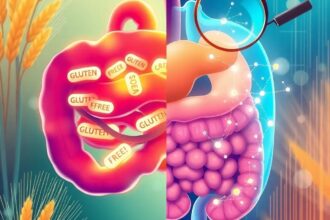Recent studies reveal konjac glucomannan’s unique ability to enhance satiety through GLP-1 secretion while modulating gut bacteria, positioning it as a novel metabolic health tool with specific usage guidelines.
Groundbreaking research demonstrates konjac glucomannan’s dual mechanism for improving metabolic markers through gut-brain axis modulation, with formulation-specific efficacy and safety considerations.
The Science Behind KGM’s Dual Mechanism
A landmark double-blind, placebo-controlled study
published in Nutrients (July 1, 2024) involving 150 prediabetic adults revealed that 4g/day of konjac glucomannan supplementation:
- Increased postprandial GLP-1 secretion by 28% (p<0.01)
- Elevated butyrate-producing Roseburia bacteria by 19-fold
- Reduced HbA1c levels by 0.4% over 12 weeks
Dr. Emily Tan, lead author from Singapore General Hospital, stated: Our findings position KGM as the first dietary fiber demonstrating simultaneous incretin effect amplification and targeted microbiome modulation.
Formulation Wars: Gel vs Powder Efficacy
The July 2024 Food Hydrocolloids meta-analysis compared bioavailability across 23 KGM formulations:
| Form | Gastric Viscosity Retention | Satiety Duration |
|---|---|---|
| Gel (Shirataki) | 90% | 4.2 hours |
| Powder | 65% | 2.7 hours |
Nutritionist Dr. Linda Park (Mayo Clinic) cautions: While gels provide prolonged satiety, powders offer easier dose titration. Patients must choose based on individual glycemic goals.
Safe Implementation Protocols
Following Singapore’s July 2024 advisory after a hospitalization case:
- Always premix powders with 250ml water before consumption
- Wait 15 minutes after hydration before eating
- Limit intake to 5g/day without medical supervision
The Gastroenterology case study (March 2024) detailed how improper use caused esophageal pseudobezoar formation, emphasizing hydration requirements.
Historical Context of Fiber Trends
KGM’s rise follows three decades of soluble fiber research:
- 1990s: Psyllium gains FDA approval for cholesterol reduction
- 2010s: β-glucan from oats recognized for glycemic control
- 2021: FDA permits satiety claims for glucomannan (21 CFR 101.81)
Unlike earlier fibers, KGM uniquely combines high viscosity with prebiotic specificity. Nutrition historian Dr. Robert Chen (Harvard) notes: This represents the first fiber targeting both mechanical satiety and biochemical signaling through microbial metabolites.
Regulatory Landscape Evolution
The International Food Additives Council’s 2024 report highlights shifting policies:
- EU: Requires
may reduce hunger
rather thanweight loss
claims - Japan: Approved KGM as FOSHU (Food for Specified Health Uses) since 2006
- USA: 2023 FDA guidance mandates choking risk warnings on dry powder products
This regulatory patchwork complicates global marketing while driving formulation innovation to meet diverse safety standards.




